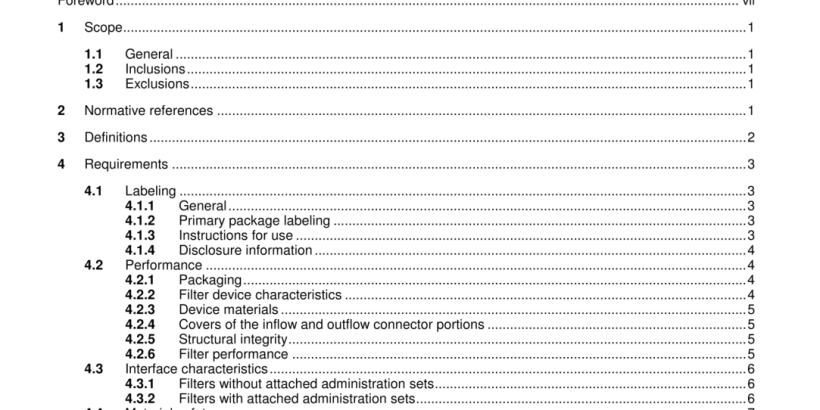ANSI AAMI 11138-5-2017 pdf download.
ANSI AAMI BF7-2012 pdf download.Blood transfusion microfilters
1 Scope
1.1 General
This standard describes safety and performance requirements for disposable microfilters used for the removal of microaggregates from blood or blood products during transfusion.
1.2 Inclusions
Included within the scope of this standard are disposable microfilters for blood and blood-derivative transfusions for adult populations only. These are sometimes also referred to as microaggregate filters.
1.3 Exclusions
Excluded from the scope of this standard are filters used for extracorporeal service and other blood filters not intended for blood transfusion. Also excluded are components of standard infusion sets designed to remove readily visible blood clots only.
NOTE For an explanation of the need for this standard, as well as the rationale for its provisions, see Annex A.
2 Normative references
The following normative documents contain provisions that, through reference in this text, constitute provisions this standard. For dated references, subsequent amendments to, or revisions of, any of these publications do not apply. However, parties to agreements based on this standard are encouraged to investigate the possibility of applying the most recent editions of the normative documents indicated below. For undated references, the latest edition of the normative document referred to applies. AAMI maintains a register of currently valid AAMI technical documents.
2.1 United States Pharmacopeia. Easton, PA: Mack Publishing.
2.2 ASTM. Method of test for pore size characteristics of membrane filters for use with aerospace fluids. ANSI/ASTM D2499-69. Philadelphia: ASTM International, 1969.
2.3 SAE. Bubble point test method. ARP-901. Warrendale, PA: Society of Automotive Engineers, 1968.
2.4 ASTM. Particles from aerospace fluids: Microscopial sizing and counting on membrane filters. ANSI/ASTM F312-69. Philadelphia: AS TM International, 1969.
2.5 SAE. Procedure for the determination of particulate contamination of hydraulic fluids by the particle count method.ARP-598. Warrendale, PA: Society of Automotive Engineers, 1960 (1969).
2.6 AAMI. Biological evaluation of medical devices, Part 4: Selection of tests for interactions with blood.ANSI/AAMI/ISO 10993-04:2002/(R)2009. Association for the Advancement of Medical Instrumentation, 2002/(R)2009.
particle longer than 100 μm with a length-to-width ratio of greater than 10:1, regardless of composition fresh blood blood that is utilized usually within 24 hours, but in no case more than 48 hours, after collection
3.3 indated blood
blood that has been preserved and stored at 10C to 6°C for a clinically acceptable period, which is based on its useful shelf-life. Currently, blood may be stored for up to 21 days in CPD (citrate phosphate dextrose) anticoagulant,for up to 35 days in CPD-A, or for up to 42 days in AS-1,AS-3, or AS-5 and still be considered in-dated.
3.4 inspection
examination (e.g, visual, auditory) and/or investigation, without the use of special laboratory appliances or procedures
3.5 latex spheres
commercially available latex spheres with a nominal diameter of 45 μm. Although alternate materials may be qualified, the work upon which the test method included in this standard is based used commercially available latex spheres with a nominal diameter of 45 μm.
3.6 outdated whole blood
blood that has been preserved and stored at 1°C to 6°C but not used within a clinically acceptable period. A hematocrit of 35 to 52%,without dilution with saline but permitting dilution with serum if necessary, is specified throughout this standard.
3.7 packed red cells
blood from which the plasma has been removed and which has a hematocrit of less than 80% without dilution (i.e.,without dilution by saline, serum, or other diluent)
4.1.1 General
The term labeling refers to any printed matter that appears on the device, its accessory items, or its container and to all documentation that accompanies the device. In addition to federal regulations applicable to the labeling of all medical devices, the requirements contained in this section shall apply to devices within the scope of this standard.
